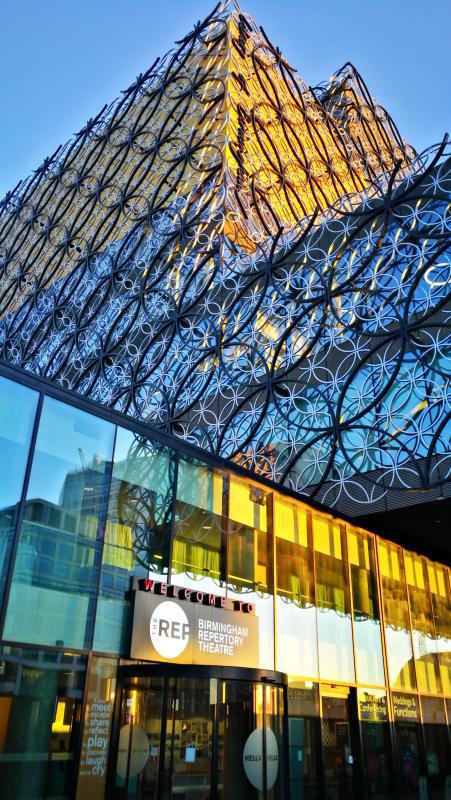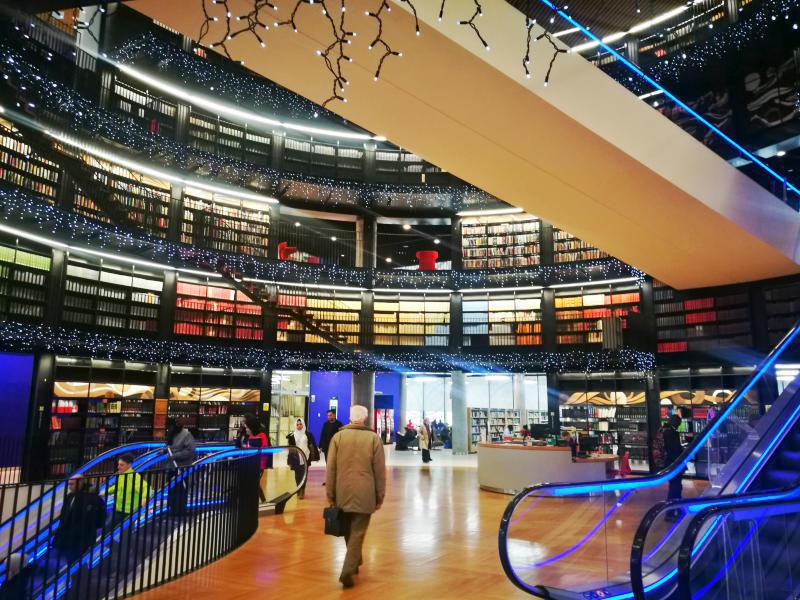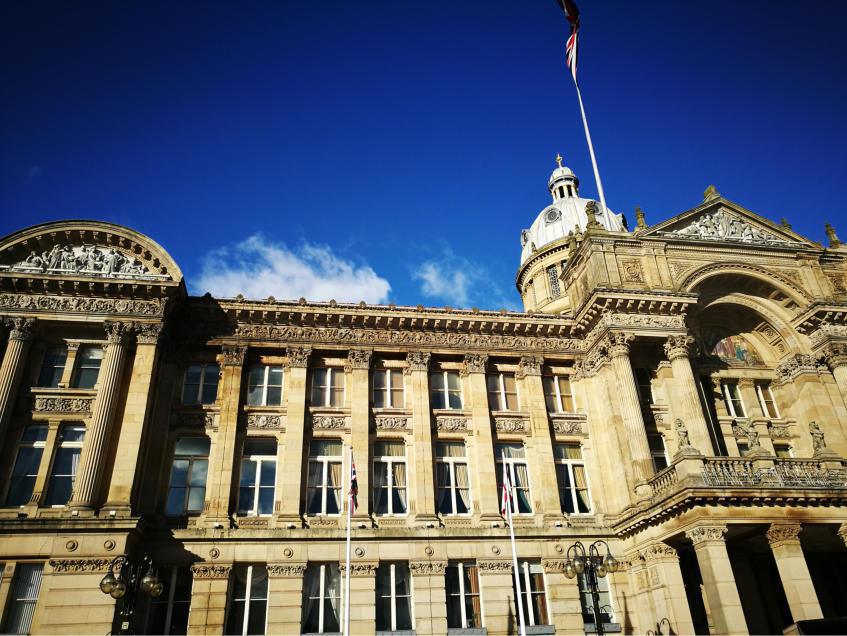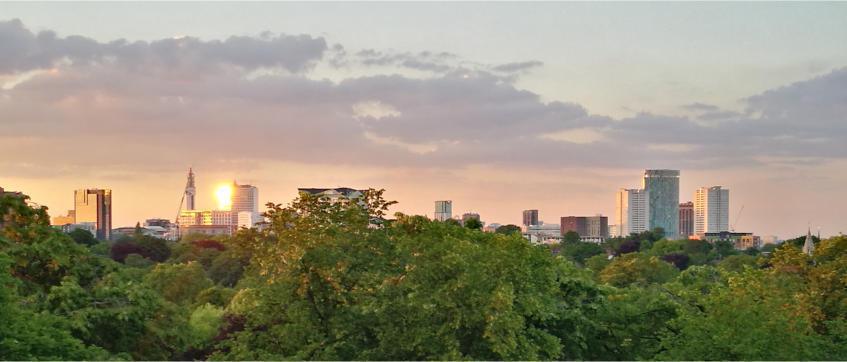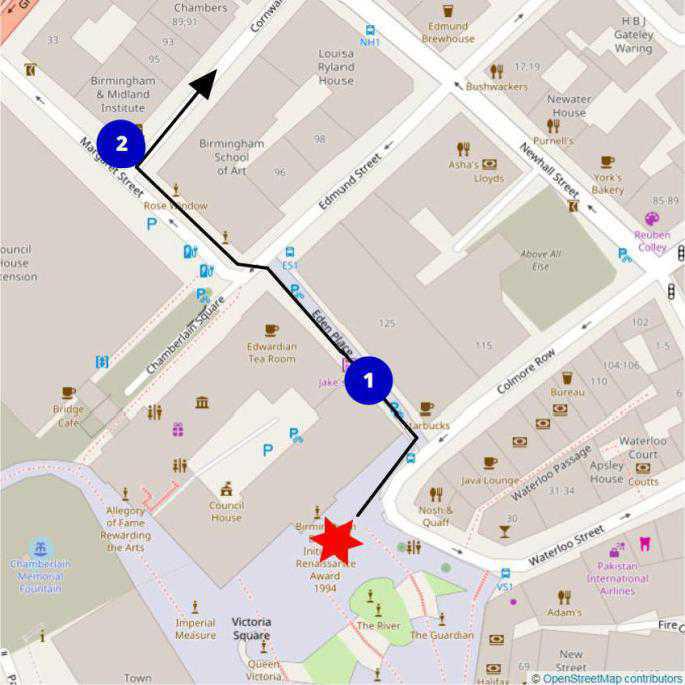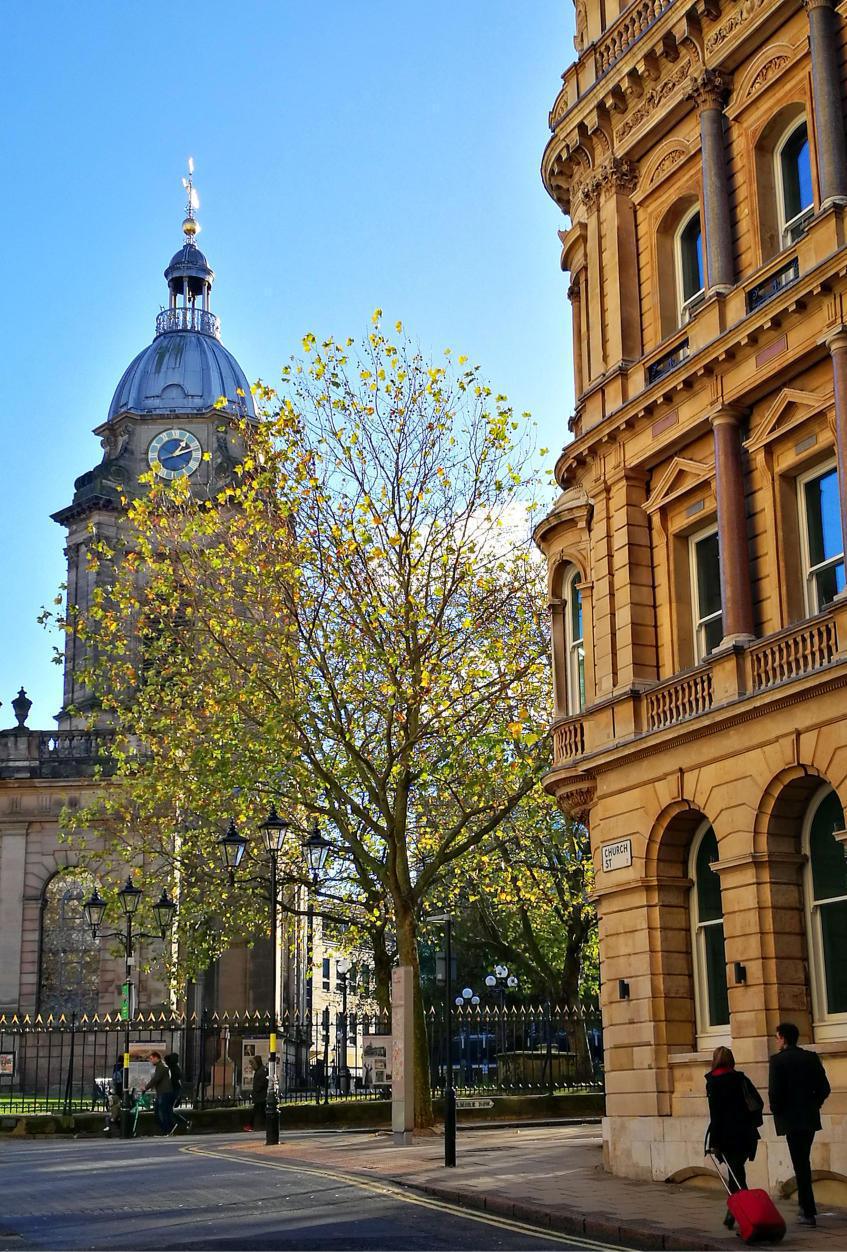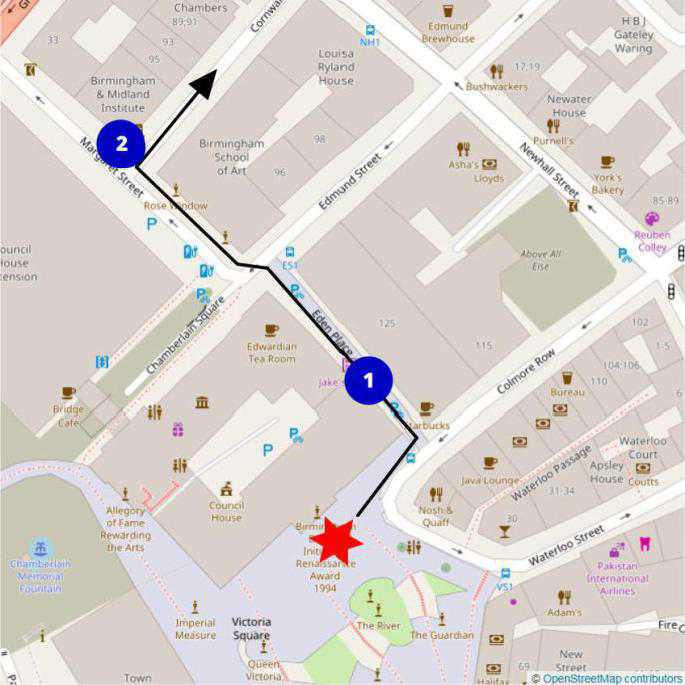Explore the heart of Shakespeare country with our self-guided tour from the Shakespeare Memorial Room at the top of the Library of Birmingham, by train to Stratford and the birthplace of the man himself!
We will start this tour at the very top of the Library of Birmingham in the Shakespeare Memorial Room (link to map location in published version) - so make your way there now.
Above: the Library of Birmingham looming over the REP Theatre entrance
The Shakespeare Memorial Room was created and designed to house the Shakespeare Memorial Library by John Henry Chamberlain in1882, a founder member of Our Shakespeare Club. He was responsible for re-building the old Central Library after the original building was gutted by fire in 1879. The Shakespeare Memorial room opened off the new wing of the L shaped reading room of the reference library on the first floor of the building. With the ever rising collection of material the Birmingham Shakespeare Library outgrew this room in 1906.
The room was highly praised and is in an Elizabethan style with carvings, marquetry and metalwork representing birds, flowers and foliage. The woodwork is by Mr Barfield, a noted woodcarver; the brass and metal work by Hardmans. The ceiling decoration is stencilled.
Above: inside the Library of Birmingham
Controversy surrounded plans to demolish the Central Library in 1971. Anthony Crossland the Environment Minister ruled that the Shakespeare Memorial room must be preserved and be readily accessible to the people of Birmingham. Various ideas included moving it to Avoncroft Buildings Museum in Bromsgrove, or relocating it to the Shakespeare Institute at Stratford. Three groups of conservationists threatened a sit in before the room was dismantled in 1974 and stored at the city’s Sheepcote Street depot in poor environmental conditions. Eventually it was re-built as part of the School of Music complex in 1986.
The Shakespeare Memorial Room is now situated on top of the Library of Birmingham and opened in September 2013.
Discover more about The Library of Birmingham in the following Youtube clip (you will need wifi or mobile data to view this, network charges may apply).
Whilst we are in the Shakespeare Memorial Room, let's learn a little more about William Shakespeare (thanks to the Royal Shakespeare Company for this information).
SHAKESPEARE'S LIFE
Very little is known for certain about William Shakespeare. What we do know about his life comes from registrar records, court records, wills, marriage certificates and his tombstone in Holy Trinity Church, Stratford-upon-Avon.
William Shakespeare was baptised on 26 April 1564 at Holy Trinity in Stratford-Upon-Avon. Traditionally his birthday is celebrated three days earlier, on 23 April, St George's Day.
SHAKESPEARE'S BIRTHPLACE
John Shakespeare married Mary Arden, the daughter of Robert Arden, a farmer from the nearby village of Wilmcote. In 1556 John bought the main part of the house in Henley Street which is now known as the 'Birthplace' and their family, including William, grew up there (see photo). John's principal business was that of a glover, but he also traded as a wool and corn merchant, and he is recorded in 1570 as being involved in money-lending.
SHAKESPEARE'S PARENTS
William's father, John Shakespeare, was an affluent glove maker, tanner and wool dealer who owned property in Stratford. For a number of years he played a prominent role in the municipal life of the town. He served on the town council and was elected bailiff (mayor). However, around 1576 John Shakespeare was beset by severe financial difficulties and he was forced to mortgage his wife's inheritance.
William's mother, Mary Arden, was the daughter of a prosperous farmer, Robert Arden, who had left her some land in Wilmcote, near Stratford. John and Mary Shakespeare had eight children: four daughters, of whom only one (Joan) survived childhood. William was the eldest of the four boys.
EDUCATION
William almost certainly went to one of Stratford's 'petty' or junior schools where he would have learnt his letters with the help of a hornbook. From the age of seven or thereabouts, he would have progressed to the King's New School where the emphasis would have been on Latin, it still being the international language of Europe in the 1500s. Shakespeare probably left school at the age of 14 or 15.
Shakespeare’s plays reveal a detailed knowledge of the curriculum taught in such schools which were geared to teaching pupils Latin, both spoken and written. The classical writers studied in the classroom influenced Shakespeare's plays and poetry; for example, some of his ideas for plots and characters came from Ovid's tales, the plays of Terence and Plautus, and Roman history.
It is not known what Shakespeare did when he left school, probably at the age of 14, as was usual.
MARRIAGE AND CHILDREN
In 1582, when he was 18, Shakespeare married Anne Hathaway. She was 26. Anne was the daughter of a well-to-do farmer, Richard Hathaway of Hewlands Farm in nearby Shottery. Their first child, Susanna, was born in May 1583. Twins, Hamnet and Judith, were christened in February 1585. Anne’s home, now known as Anne Hathaway's Cottage, still stands in the village of Shottery.
From 1585 until 1592, very little is known about Shakespeare. These are generally referred to as 'The Lost Years'. But by 1592 we know that he was in London where he was singled out by a rival dramatist, Robert Greene in his bitter deathbed pamphlet, A Groats-worth of Witte.
WRITING AND ACTING
Plague broke out in London in 1593, forcing the theatres to close. Shakespeare turned to writing poetry. In 1593 Shakespeare published an erotic poem, Venus and Adonis, dedicated to Henry Wriothesley, Third Earl of Southampton, a young courtier and favourite of Queen Elizabeth.
Shakespeare's earliest plays included Henry VI Parts I, II & III, The Two Gentlemen of Verona, and Titus Andronicus. The sonnets were also written about this time, though they were not published until 1609.
In 1594, Shakespeare became a founding member, actor, playwright and shareholder of the Lord Chamberlain's Men. Richard Burbage was the company's leading actor. He played roles such as Richard III, Hamlet, Othello and Lear. Under James VI/I, the company was renamed The King's Men. They performed at court more often than any other company.
DRAMA IN SHAKESPEARE'S STRATFORD
In Shakespeare's youth, Stratford was often visited by travelling troupes of professional actors. These players probably sparked his interest in the stage, and he may have entered the London theatre world though contacts made with them in Stratford.
We don't know when or why Shakespeare left Stratford for London, or what he was doing before becoming a professional actor and dramatist in the capital. There are various traditions and stories about the so-called 'lost years' between 1585 and 1592, a period for which there is virtually no evidence concerning his life.
WEALTH
Whereas John Shakespeare had lost a fortune, his son managed to amass great wealth in his lifetime.
In 1597, he bought New Place, one of the largest properties in Stratford. In 1598, he is listed as a resident of Chapel Street ward, in which New Place was situated. In 1601, when his father died, he may also, as the eldest son, have inherited the two houses in Henley Street.
In 1602 Shakespeare paid £320 in cash to William Combe and his nephew John for roughly 107 acres of land in Old Stratford.
He also bought a cottage and more land in Chapel Lane. In 1605, for £440, Shakespeare bought a half-interest in a lease of many tithes which brought him an annual interest of £60. When he died in 1616, he was a man of substantial wealth.
LAST YEARS
Shakespeare's elder daughter, Susanna, married a physician, John Hall in Stratford in 1607. Their only child, a daughter, Elizabeth, was born in 1608, the year in which Shakespeare's mother died. Judith Shakespeare, his younger daughter, married a vintner, Thomas Quiney in 1616. They had three sons: Shakespeare Quiney, who died in infancy; Richard (1618-139) and Thomas (1620-1639).
Sometime after 1611, Shakespeare retired to Stratford. On 25 March 1616, Shakespeare revised and signed his will. On 23 April, his presumed birthday, he died, aged 52. On 25 April, he was buried at Holy Trinity Church in Stratford.
Shakespeare's widow, Anne, died in 1623 and was buried beside him. Shakespeare's family line came to an end with the death of his grand-daughter Elizabeth in 1670.
In 1623, seven years after Shakespeare's death, John Heminge and Henry Condell (two actors from The King's Company) had Shakespeare's plays published by William Jaggard and his son, Isaac. This first folio contained 36 plays and sold for £1.
The University of Birmingham's Shakespeare Institute is a world-renowned centre of excellence in Shakespeare research and renaissance drama. Located in the heart of idyllic Stratford-upon-Avon, the birthplace of the Bard himself, there are few more fitting locations to study the works of Shakespeare. The Institute benefits from key collaborations and partnerships, such as with the Royal Shakespeare Company’s studio theatre ‘The Other Place’, the Shakespeare Birthplace Trust and a range of local Shakespeare projects, as well as having its own purpose-built research library. The Director of the Shakespeare Institute, Professor Michael Dobson, and his fellow researchers and academics are dedicated to keeping Shakespeare a prominent and active figure in contemporary literature, to ensure that his work lives on.
Shakespeare Today
Shakespeare transcends time and space, his works are more popular and more studied now than any point in the last 400 years. Shakespeare’s plays and poems have spread across the globe, adapted both for and by myriad countries, cultures and languages.
There is a misconception that Shakespeare is a British poet and playwright. The Shakespeare Institute however, is constantly working to overcome this notion; keen to stress that his plays and poems are valid for all people, and have been studied and adapted across the world, performed in different accents and dialects, set in diverse countries and to audiences of all ages and backgrounds. Shakespeare is not a British playwright, he is a global one.
Britain, and particularly England, often claims Shakespeare as its own - the country’s mark on the great literature of the ages. However, although Shakespeare may have been born in middle-England, his work is not British. Only a limited number of plays are set in Britain; they are also set in Italy, Greece, Denmark and some in magical, far-away fantasy lands.
The researchers and academics at the Shakespeare Institute are dedicated to ensuring that Shakespeare lives on in society. Reimagining the way that he is perceived, studied and how people interact with Shakespeare’s work today, the Institute is pushing the boundaries of knowledge about Shakespeare studies. The Shakespeare Institute ensures that Shakespeare’s work continues to inspire others today.
Professor Michael Dobson points out that the Shakespeare Institute is a hub of ideas, a database for those interested in Shakespeare across the world, not just scholars. Offering Massive Open Online Courses (MOOCs) in Hamlet and Othello and having a strong desire to branch out further into other plays, the Institute is - much like Shakespeare - a global Institution, dedicated to maintaining and furthering Shakespeare’s international popularity.
Read more about their work at https://www.birmingham.ac.uk/research/heroes/shakespeare.aspx
Above: Birmingham Council House
We will now walk from the Library to Snow Hill Train Station where we can catch our train to Stratford. This is a direct service taking between approx 45 minutes to an hour, depending on service. First, check to make sure the trains are running using the following (internet or mobile data connection required):
If your train is running, let's now walk to the train station. If you have more time, why not do our City Centre walking tour of Birmingham first, or one of our other walks around Birmingham.
Turn left out of the Library and follow the pathway through the new construction of Paradise Circus. You will see the collonnades of Birmingham Town Hall on your right and just past here ahead of you will be the entrance to Birmingham Museum & Art Gallery.
Above: view of Birmingham City Centre over the treetops of Edgbaston
The Grade I listed Town Hall is one of the oldest concert halls in the world, and has been at the centre of Birmingham’s cultural life since it opened in 1834. Charles Dickens gave his first public reading of A Christmas Carol on Town Hall’s stage, Mendelssohn’s Elijah and Elgar’s The Dream of Gerontius received their premieres in the hall, and in the 1950s to 1970s the venue played host to many of the biggest names in popular music such as Led Zeppelin, Buddy Holly, Chuck Berry and the Beatles. See more at https://www.thsh.co.uk/
The vibrant Birmingham Museum & Art Gallery has over 40 galleries displaying world-class collections of art, social history, archaeology and ethnography. Packed with interactive activities and designed to appeal to all senses, the museum is a beautiful space for all to connect with our world’s past. You can step inside a 17th century painting, eavesdrop on Albert Einstein or simply stand back and see major works by the Old Masters and Impressionists, as well as rub shoulders with Rossetti and Burne-Jones in the world’s largest public collection of Pre-Raphaelite art. With the most highly valued hoard of Anglo-Saxon gold, the largest known complete Indian bronze sculpture and a whole collection of Egyptian mummies and coffins, Birmingham Museum and Art Gallery is a treasure trove on the map of arts and culture. See more at http://www.birminghammuseums.org.uk/bmag
Above: example of a static in-route map - not actual route in this one!
Walk between the Museum (on your left) and the Town Hall (on your right) then turn left around the edge of the Museum building into Victoria Square. Birmingham Council House will be on your left (part of the same building as the Museum).
Birmingham City Council House was built between 1874 and 1879, designed by Yeoville Thomason. It is now a Grade II listed building, used for all Council and most Committee meetings. The front, facing Victoria Square, has a pediment showing Britannia receiving the manufacturers of Birmingham.
Continue across Victoria Square with the Council House on your left. You will emerge onto Colmore Row - keep going straight ahead, crossing over Newhall Street and you will reach the green space surrounding St. Philip's Cathedral of Birmingham
Above: View of St. Philip's Cathedral of Birmingham
The Cathedral Church of Saint Philip is a Church of England cathedral and the seat of the Bishop of Birmingham. Built in 1715, it is Grade I listed and the third smallest cathedral in England after Derby and Chelmsford. During the Second World War, the cathedral was bombed on the 7 November 1940. Its most significant treasures, the inspiring stained glass windows by Edward Burne-Jones, had been removed early in the war to be replaced, unharmed, when the building was restored in 1948. See more at http://www.birminghamcathedral.com/
Above: example of a static in-route map - not actual route in this one!
Continue straight ahead along Colmore Row, passing by Ludgate Street and Church Street on your left, and then you will reach Snow Hill Train Station on your left hand side. Catch your train to Stratford here!
Above: unfortunately your train won't look like this one!
Welcome to Stratford-upon-Avon!
We will now walk over to Shakespeare's Birthplace to see where it all began. If you prefer a taxi, click on the link to UBER below.
Insert link to UBER above in case taxi is preferred to walking! No link included in this example.
As you exit the train station turn right onto Brunel Way. Follow it to the left, then right and it ends at traffic lights on Alcester Road. Turn left here and walk down to the next junction with Arden Street on your left. Cross over Arden Street at the pedestrian crossing then turn left to walk down Arden Street. Take the first road on the right - Mansell Street. Walk all the way to the end then turn left into Windsor Street. Walk along here, crossing over to the other side when safe to do so, and take the first road on the right into Henley Street. You will find the Shakespeare Birthplace centre just down here on the left.
Visit Shakespeare’s Birthplace to walk in Shakespeare’s footsteps and explore the house where he was born and grew up. Hear tales of Shakespeare’s family life, enjoy live theatre on demand and get up close to rare artefacts from the Trust’s world class collections as you discover how the extraordinary William Shakespeare continues to shape our lives today. See more at https://www.shakespeare.org.uk/visit/shakespeares-birthplace/
Why not listen to a podcast from The Shakespeare Institute of The University of Birmingham explaining "How did Shakespeare Get so Popular? "
We hope you enjoyed your Shakespeare Tour from Visit Birmingham.


